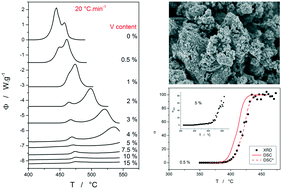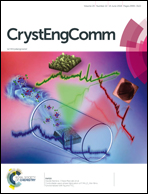Crystal formation in vanadium-doped zirconia ceramics
Abstract
Differential scanning calorimetry and in situ X-ray diffraction analysis were used to study the products and mechanism of crystal formation in VOx–ZrO2 ceramics. Concentration series of up to 15 wt% V deposited on the surface of the amorphous ZrO2 support was treated non-isothermally and the formation of tetragonal ZrO2 crystalline phase was observed. The crystal growth proceeded via two independent mechanisms: one originating from surface defects-based active crystallization centers and the other from homogeneously distributed surface nuclei. Vanadium was found to markedly hinder both crystallization processes. The preferential occupation of the active surface sites by V atoms lead to an abrupt cessation of the associated growth process, which is in favor of the growth from homogeneous surface nuclei, which was only slowly delayed and suppressed with increasing VOx content. Application of the multivariate kinetic analysis method allowed for a precise kinetic description of the complex crystallization behavior, exhibiting an overlap of the two growth processes. The kinetics of both crystal growth processes were described by an nth order autocatalytic model. Reproducible and monotonous compositional trends of all kinetic parameters (activation energies, pre-exponential factors and kinetic model exponents), determined by multivariate kinetic analysis provide an excellent basis for precise predictions, allowing development of finely tuned VOx–ZrO2 ceramics.



 Please wait while we load your content...
Please wait while we load your content...